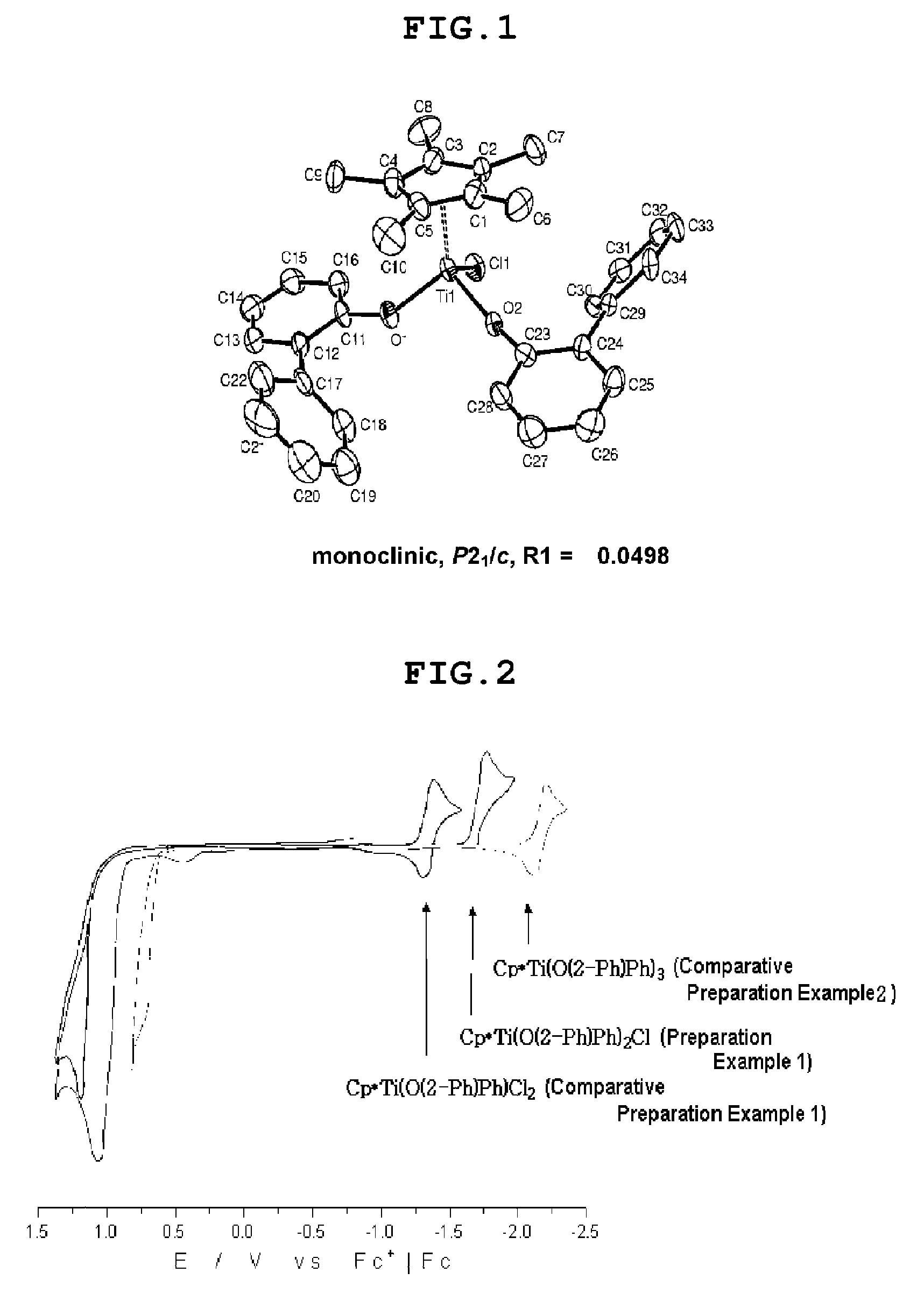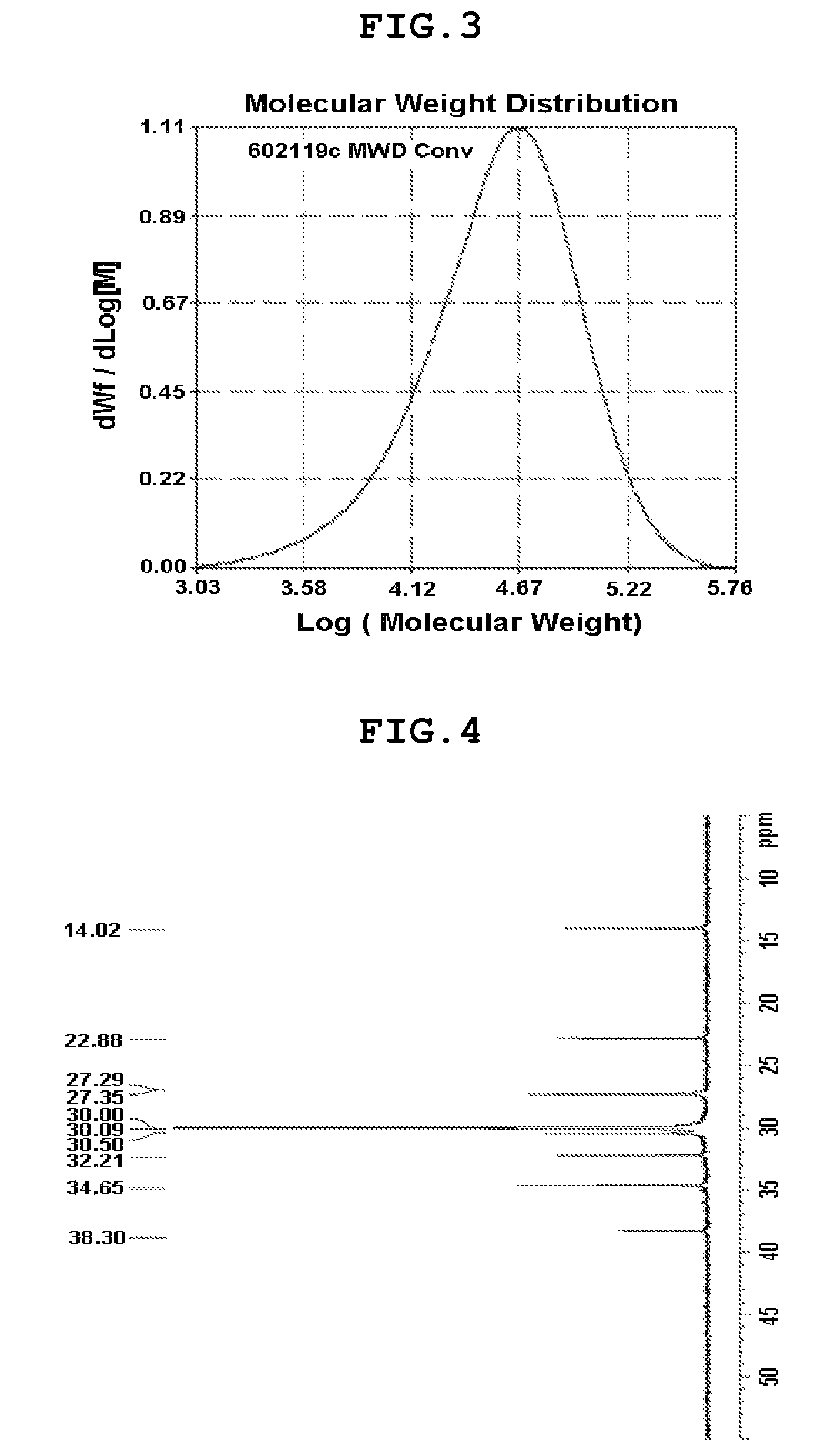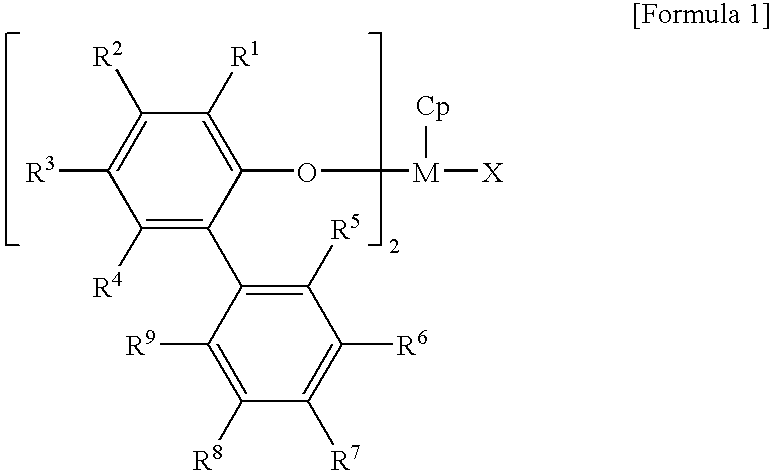Bis-arylaryloxy catalytic system for producing ethylene homopolymers or ethylene copolymers with alpha-olefins
a technology of ethylene homopolymer and ethylene copolymer, which is applied in the direction of catalyst activation/preparation, chemical/physical processes, and bulk chemical production, etc., can solve the problems of unsuitability of the catalyst system, difficult to achieve the catalyst system, and uneven composition distribution, etc., to achieve excellent catalytic activity and high activity
- Summary
- Abstract
- Description
- Claims
- Application Information
AI Technical Summary
Benefits of technology
Problems solved by technology
Method used
Image
Examples
preparation example 1
Synthesis of 2-phenyl-4-fluorophenol
[0054]2-bromo-4-fluorophenol (4.16 g, 20.32 mmol, Aldrich) was added into the flask, and then nitrogen was introduced thereto. Palladium acetate (0.22 g, 1.02 mmol), potassium phosphate (21.00 g, 91.19 mmol), phenylboronic acid (2.97 g, 24.36 mmol) and triphenylphosphine (0.80 g, 3.06 mmol) were additionally added into the flask. DME (32 ml) and distilled water (8 ml) were added into, followed by stirring well. The mixture was heated to 50° C. and then stirred for 6 hours. After completion of the reaction, the reaction product was cooled to room temperature, and the organic layer was separated with ammonium chloride diethylether (10 ml×3) and distilled water. Then, magnesium sulfate was added to the collected organic layer, followed by stirring for 30 minutes. The mixture was filtered and treated to remove volatile material, thus obtained material was cooled to −78° C. followed by slowly adding borontribromide (30.48 ml, 1.0M in methylene chloride...
preparation example 2
Synthesis of bis(pentamethylcyclopentadienyl)(2-phenyl-4-fluorophenoxy)titanium(IV) chloride
[0056]After 1.90 g (10.09 mmol) of 2-phenyl-fluorophenol was dissolved with 80 ml of diethylether, 4.8 ml of butyl lithium (2.5M hexane solution) was slowly added thereon dropwise at 0° C. After reacting for 5 hours at the room temperature, a solution of trichloro(penta methylcyclopentadienyl)titanium(IV) (1.64 g, 5.5 mmol) in 10 ml diethylether was slowly added dropwise at −78° C. Thus obtained material was stirred for 12 hours at the room temperature followed by filtering, and then volatile components were removed followed by recrystallizing with mixing solution of toluene / hexane at −35° C. to yield 2.54 g of an orange-colored solid.
[0057]Yield: 85%, 1H-NMR (C6D6) δ=1.46 (s, 15H), 6.65-7.57 (m, 8H)
preparation example 3
Synthesis of 2-(4-trifluoromethylphenyl)phenol
[0058]4-trifluoromethylbromobenzene (4.57 g, 20.32 mmol, Aldrich) was added into the flask, and then nitrogen was introduced thereto. Palladium acetate (0.22 g, 1.02 mmol), potassium phosphate (21.00 g, 91.19 mmol), 2-methoxy boronic acid (3.71 g, 20.32 mmol, Aldrich) and triphenylphosphine (0.80 g, 3.06 mmol) were additionally added into the flask. DME (32 ml) and distilled water (8 ml) were added into, followed by stirring well. The mixture was heated to 50° C. and then stirred for 6 hours. After completion of the reaction, the reaction product was cooled to room temperature, and the organic layer was separated with ammonium chloride diethylether (10 ml×3) and distilled water. Then, magnesium sulfate was added to the collected organic layer, followed by stirring for 30 minutes. Mixture was filtered and treated to remove volatile material. Thus obtained material was introduced to dried flask followed by being dissolved with methylene ch...
PUM
| Property | Measurement | Unit |
|---|---|---|
| molar ratio | aaaaa | aaaaa |
| pressure | aaaaa | aaaaa |
| temperature | aaaaa | aaaaa |
Abstract
Description
Claims
Application Information
 Login to View More
Login to View More - R&D
- Intellectual Property
- Life Sciences
- Materials
- Tech Scout
- Unparalleled Data Quality
- Higher Quality Content
- 60% Fewer Hallucinations
Browse by: Latest US Patents, China's latest patents, Technical Efficacy Thesaurus, Application Domain, Technology Topic, Popular Technical Reports.
© 2025 PatSnap. All rights reserved.Legal|Privacy policy|Modern Slavery Act Transparency Statement|Sitemap|About US| Contact US: help@patsnap.com



